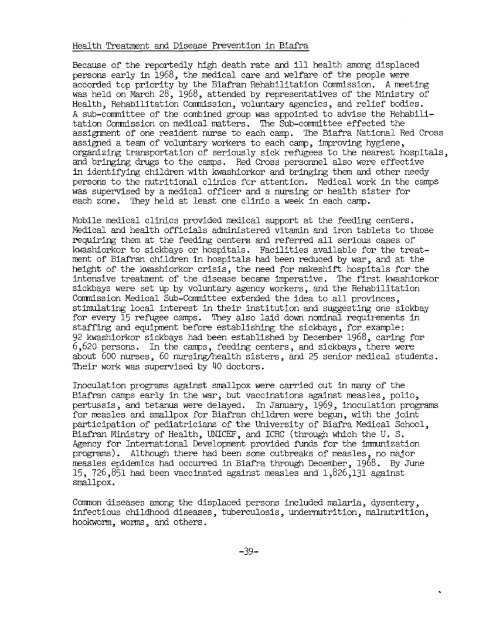3. - usaid
3. - usaid
3. - usaid
Create successful ePaper yourself
Turn your PDF publications into a flip-book with our unique Google optimized e-Paper software.
Health Treatment and 'Disease .Prevent ion 'in 'Biaf'ra<br />
Because of the reportedly high death rate and ill health among displaced<br />
persons early in 1968, the medical care and welfare of the people were<br />
accorded top priority by the Biafran Rehabilitation Commission. A meeting<br />
was held on March 28, 1968, attended by representatives of the Ministry of<br />
Health, Rehabilitation Conmission, voluntary agencies, and relief bodies.<br />
A sub-comnittee of the combined group was appointed to advise the Rehabilitation<br />
Connnission on medical matters. The Sub-committee effected the<br />
assigmnent of' one resident nurse to each camp. The Biafra National Red Cross<br />
assigned a team of voluntary workers to each camp, improving hygiene,<br />
organizing transportation of seriously sick remees to the nearest hospitals,<br />
and bringing drugs to the camps. Red Cross personnel also were effective<br />
in identifying children with kwashiorkor and bringing them and other needy<br />
persons to the nutritional clinics fcr attention. Medical work in the camps<br />
was supervised by a medical officer and a nursing or health sister for<br />
each zone. They held at least one clinic a week in each camp.<br />
Mobile medical clinics provided medical support at the feeding centers.<br />
Medical and health officials administered vitamin and iron tablets to those<br />
requiring them at the feeding centers and referred all serious cases of<br />
kwashiorkor to sickbays or hospitals. Facilities available for the treatment<br />
of BiafYan chlldren in hospitals had been reduced by war, and at the<br />
height of the kwashiorkor crisis, the need for makeshifi hospitals for the<br />
intensive treatment of the disease became imperative. The first kwashiorkor<br />
sickbays were set up by voluntary agency workers, and the Rehabilitation<br />
CorrPnission Medical Sub-Committee extended the idea to all provinces,<br />
stirmrlating local interest in their institution and suggesting one sickbay<br />
for every 15 refugee camps. They also laid down nominal requirements in<br />
staffing and equipment before establishing the sickbays, for example:<br />
92 kwashiorkor sickbays had been established by December 1968, caring for<br />
6,620 persons. In the camps, feeding centers, and sickbays, there were<br />
about 600 nurses, 60 nursing/health sisters, and 25 senior medical students.<br />
Their work was supervised by 40 doctors.<br />
Inoculation pr-ograms against smallpox were carried out in many of the<br />
Biafran camps early in the war, but vaccinations against measles, polio,<br />
pertussis, and tetanus were delayed. In January, 1969, inoculation programs<br />
for measles and smallpox for Biafran children were begun, with the joint<br />
participation of pediatricians of the University of Biaf'ra Medical School,<br />
Biaf'ran Ministry of Health, UNICEF, and ICRC (through which the U. S.<br />
Agency for International Development provided funds for the irmmization<br />
programs). Although there had been some outbreaks of measles, no major<br />
measles epidemics had occurred in Biaf'ra through December, 1968. By June<br />
15, 726,851 had been vaccinated against measles and 1,826,Ul against<br />
smallpox.<br />
Comon diseases among the displaced persors included malaria, dysentery,<br />
infectious childhood diseases, tuberculosis, undermutrition, malnutrition,<br />
hookworm, worms, and othe~s.
















